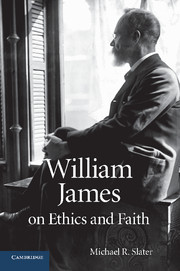Book contents
- Frontmatter
- Contents
- Acknowledgements
- Introduction: a practical faith
- PART I PRACTICAL FAITH AND THE WILL TO BELIEVE
- 1 The will and the right to believe
- 2 James's Wager and the right to believe
- PART II TWO MORAL ARGUMENTS FOR RELIGIOUS FAITH
- PART III PIECEMEAL SUPERNATURALISM AND PRACTICAL NEEDS
- Epilogue
- Bibliography
- Index
2 - James's Wager and the right to believe
Published online by Cambridge University Press: 03 February 2010
- Frontmatter
- Contents
- Acknowledgements
- Introduction: a practical faith
- PART I PRACTICAL FAITH AND THE WILL TO BELIEVE
- 1 The will and the right to believe
- 2 James's Wager and the right to believe
- PART II TWO MORAL ARGUMENTS FOR RELIGIOUS FAITH
- PART III PIECEMEAL SUPERNATURALISM AND PRACTICAL NEEDS
- Epilogue
- Bibliography
- Index
Summary
The previous chapter examined James's will to believe or right to believe doctrine, including its psychological and epistemological aspects and its defense of a highly generalized conception of religious belief which James terms “the religious hypothesis.” This chapter will concentrate on James's fi nal statement of his doctrine in the essay “Faith and the Right to Believe,” which serves as the appendix to his last book, Some Problems of Philosophy (1911). It shows that James did not rest content with merely defending our right to adopt any hypothesis that is live enough to tempt our will and is evidentially or intellectually inconclusive, but that he also used his doctrine as a means of justifying his belief in a “ pluralistic-melioristic” universe – that is, his belief in an unfinished and essentially social universe that we can help to perfect through our good faith efforts and with the assistance of God or other superhuman forces (P, 143–44; SPP, 116). As Chapter 6 will show, James's idea of a pluralistic- melioristic universe presupposes not only the existence of superhuman forces (or what he here simply calls “the other powers”) but also their assistance in our moral efforts, for what is at stake is not simply the improvement of the world but its ultimate unification and salvation.
- Type
- Chapter
- Information
- William James on Ethics and Faith , pp. 48 - 66Publisher: Cambridge University PressPrint publication year: 2009



